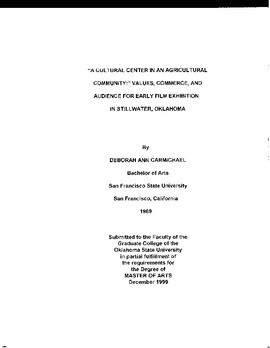| dc.description.abstract | Traditionally, most research has focused on urban moviehouses and metropolitan moviegoers. As Kathryn Fuller has noted, " ... in the early 1900s non-urban settlements still predominated. The United States was not yet a fully urban nation; 70 percent of its citizens resided outside the major cities in rural areas and small towns of ten thousand or fewer in population" (x). Although studies of small town film exhibition have increased, there remains a need for case studies such as the one offered here. A majority of the small towns previously researched were well-established communities long before the introduction of movies. Stillwater, Oklahoma, settled in 1889, provides a unique opportunity to chart the growth of film exhibition in this new town in relationship with the equally new film industry. The history of Stillwater moviehouses supports Fuller's conviction that research limited to cities, such as New York, distorted assessment of the cultural impact of film (xi). As immigrant entrepreneurs opened storefront nickelodeons in low-rent neighborhoods, movies came to be seen by the urban, cultural elite as "low-brow'' entertainment for the unwashed. This misconception prevailed although the filmgoing experience outside large cities disproves this. The first movie exhibition in Stillwater, with the exception of itinerant exhibitors, commenced at the Grand Opera House. The first storefront nickelodeon in Stillwater, opened by volunteer firemen, provided financial support for public safety. Audiences crossed social boundaries, including both more affluent townsfolk and farmers from the surrounding area, as evidenced in moviehouse advertisements in Stillwater's two newspapers; a daily paper targeting city residents and a weekly, filled with farm reports. Much of my research has relied upon accounts from these two periodicals, The Stillwater Daily Press and The Stillwater Gazette, from 1925 to 1948. City directories and opening-night souvenir programs from both the Campus and the Leachman theaters provided additional information. Also, I accidentally discovered--and, thankfully, was allowed to use--an unpublished manuscript compiled from company records of Griffith Brothers, the exhibition circuit which controlled most of Stillwater's moviehouses until 1983. Federal Supplements outlined the anti-trust case I describe. I also consulted several secondary sources concerned with Stillwater's history. These sources included articles from The Payne County Historical Review, Robert Cunningham's Stillwater Through the Years, and Earl Newsom's Pictorial History of Stillwater. In researching Hollywood's history I did not limit my reading to current publications. Referring to titles published in the 1930s and 1940s offered an insight into earlier perceptions of the film industry's growth. | |
